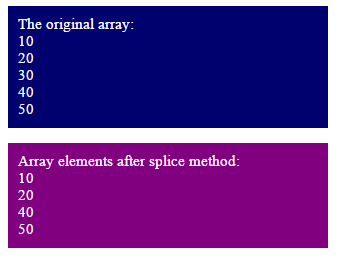

I hope it helps, feel free to ask if you have any queries about this blog or our JavaScript and front-end engineering services. If either argument is greater than the Array’s length, either argument will use the Array’s length If either argument is NaN, it is treated as if it were 0. shows, original array remains intact. Use negative numbers to select from the end of an array. If omitted, all elements from the start position and to the end of the array will be selected.

An integer that specifies where to end the selection. Use negative numbers to select from the end of an array.Īrgument 2: Optional. An integer that specifies where to start the selection (The first element has an index of 0). The slice() method can take 2 arguments:Īrgument 1: Required. If Argument(1) or Argument(2) is greater than Array’s length, either argument will use the Array’s length.Ĭonsole.log(array7.splice(23,3,"Add Me")) Ĭonsole.log(array7.splice(2,34,"Add Me Too")) Ĥ. If Argument(2) is less than 0 or equal to NaN, it is treated as if it were 0.Ĭonsole.log(array6.splice(2,-5,"Hello")) Ĭonsole.log(array6.splice(3,NaN,"World")) If Argument(1) is NaN, it is treated as if it were 0.Ĭonsole.log(array5.splice(NaN,4,"NaN is Treated as 0")) shows, returned removed item(s) as a new array object.Ĭonsole.log(arra圓.splice(2,1,"Hello","World")) deleteCount (Optional value) : It is the number of elements. The syntax of the splice () method is as below : array.splice(startIndex, deleteCount, items) Here, startIndex : It is the start index of the array from where splice () will start deleting the items. The new item(s) to be added to the array. splice () can modify the array elements or we can say that it is a mutator method. And if not passed, all item(s) from provided index will be removed.Īrgument 3…n: Optional. If set to 0(zero), no items will be removed. An integer that specifies at what position to add /remove items, Use negative values to specify the position from the end of the array.Īrgument 2: Optional. Vanilla JavaScript Slice vs Splice sliced array.slice(0, 4) (sliced) // 1, 2, 3, test slicedString string.slice(0, 5) (slicedString). The splice() method can take n number of arguments:Īrgument 1: Index, Required. But unlike slicing a cake, slicing an array does not cut the actual array, but keeps it unmodified (infinite cake).

As the name suggests, it is used to slice elements out of an array. The splice() method changes the original array and slice() method doesn’t change the original array.ģ. () () is used to slice an array from the start point to the end point, excluding the end. The splice() method returns the removed item(s) in an array and slice() method returns the selected element(s) in an array, as a new array object.Ģ.


 0 kommentar(er)
0 kommentar(er)
